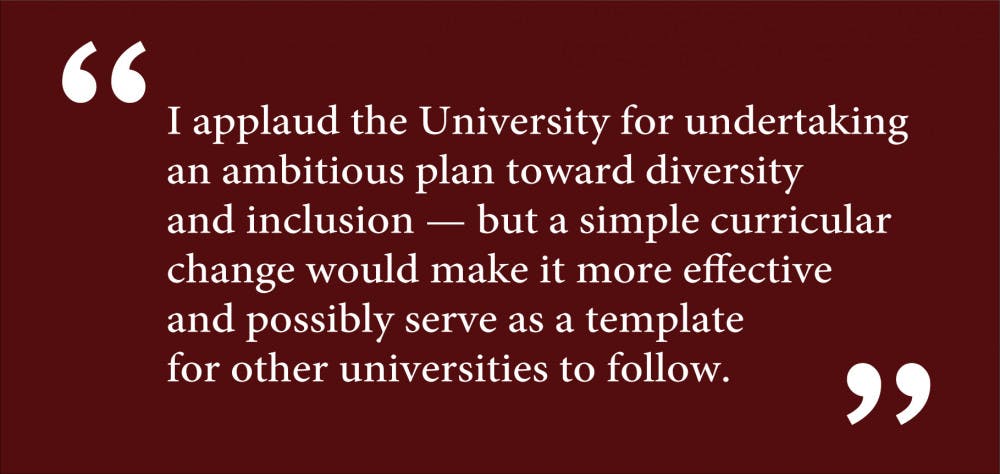A year and a half ago, President Christina Paxson P’19 released the University’s landmark Diversity and Inclusion Action Plan. The plan has six designated categories: people, academic excellence, curriculum, community, knowledge and accountability. The University has demonstrated commitment to several of these areas. It has actively tried to recruit a diverse group of faculty and graduate students, supported a range of campus life centers including the Brown Center for Students of Color and the First Generation College and Low-Income Student Center and published regular progress reports to hold itself accountable.
But less attention has been paid to two categories that are especially relevant to the student learning experience — academic excellence and curriculum. These two categories specifically aim to introduce inclusive, socially aware and diverse ideas into our academic discourse. By extension, it seems only fitting for the DIAP to also require all undergraduate students to take at least one race, gender and sexuality, inequality or social justice-related course during their four years at Brown. This requirement would build on the potential of the DIAP by not only reaffirming the importance of diversity in the community, but also prioritizing diverse perspectives in academia.
Currently, Brown has Diverse Perspectives in Liberal Learning courses that aim to “expose and critique the diverse historical and cultural forces that shape the construction of knowledge in all disciplines.” These courses are searchable via Courses@Brown under the acronym “DPLL.” However, by next fall, this will be replaced with a new searchable acronym: “DIAP.” Even though these courses are labeled and easy to find online, the designation itself doesn’t ensure that students who arguably need to take the courses most — students who have not had access to these conversations and modes of thought before coming to Brown — actually do so. This is precisely where a DIAP-mandated course requirement could help.
Brown has been historically considered a liberal institution that allows students to craft our degrees in ways that suit us best — something we don’t see in many other universities. It strives to place more value on the process of learning during class time and long thereafter, and does not place undue importance on grades or other markers of achievement. DIAP courses fit into this model because they provide us with knowledge that is not only useful to our academic growth, but also to our ongoing engagement with the world around us. Thus, a requirement for all students to take at least one DIAP-designated course would allow Brown to promote diverse thinking among all of its future graduates, instead of only the select few who opt in to these courses voluntarily.
Plus, it’s more important than ever that students understand how to maneuver the complex maze that is the current political climate. Educating students on the reality around us — say, the gender pay gap or the racial disparities in arrests and sentencing — will position them to be more informed and better able to conduct themselves in a rapidly changing and liberalizing world. In our polarized political moment, when a sitting president has been caught on tape bragging about sexual assault and has refused to unequivocally denounce the neo-Nazi groups that wreaked havoc on Charlottesville in August, it is imperative that all students emerge from Brown as informed, ethical citizens and voters. Ensuring that they engage, at least once, with the type of material covered in DIAP courses is one way to further this end.
One obvious concern with any curricular requirement at Brown is that it infringes on the Open Curriculum. Yes, this openness is important because it allows students the flexibility to take a broad range of courses within and outside of their disciplines while remaining on track to graduate. But the DIAP graduation requirement would work in a similar way to the already existing writing requirement, which does not undercut the integrity of the Open Curriculum. The writing requirement was mandated because the ability to write was seen as a basic life skill — but so is understanding the social context around us. If anything, undervaluing this critical life skill would be a disservice to students, who will need this knowledge moving forward. And, unlike the writing requirement, a DIAP requirement could be just one course over eight semesters, which isn’t asking very much. And considering that diversity and inclusion are of the utmost importance across all disciplines, it will be easy for the computer scientist, art historian and physicist alike to find DIAP courses that intersect with their academic interests.
I applaud the University for undertaking an ambitious plan toward diversity and inclusion — but a simple curricular change would make it more effective and possibly serve as a template for other universities to follow. Simply allowing DIAP courses to be searchable via Courses@Brown is not enough; if students are not obligated to look for them, labeling courses as “DIAP” adds virtually nothing to the inclusion and awareness that the University seeks to promote with the designation. With all due respect to what is, in essence, a strong and thoughtful plan for the University to engage with diversity, the longevity and productivity of the current DIAP pale in comparison to what they could be. The five-year plan is a great start, but its mission of diversity and inclusion can live on for decades more if each future graduate is required to take a DIAP course to graduate.
Randi Richardson ’20 can be reached at randi_richardson@brown.edu. Please send responses to this opinion to letters@browndailyherald.com and other op-eds to opinions@browndailyherald.com.



